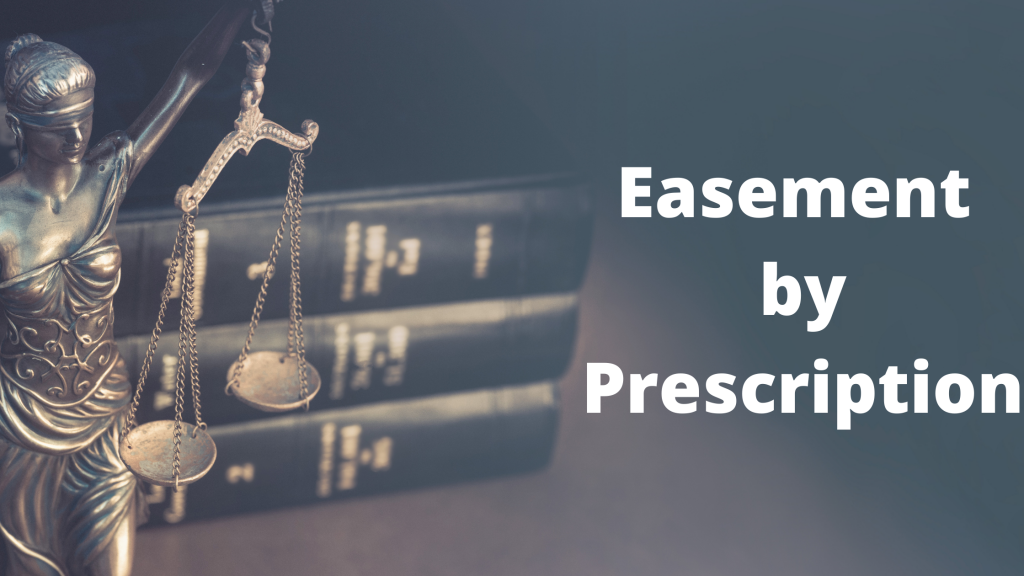A prescriptive easement is one of the more important elements of property law in the United States. This is because prescriptive easement situations occur all the time, particularly in rural areas. A shortcut across a field or forest can easily create a situation where prescriptive easement needs to be argued before the courts. So, what is a prescriptive easement? How is it different from adverse possession? How can you prevent easement by prescription from occurring? Let us explain.
What is Easement by Prescription?
In the United States, there are two important legal doctrines related to border disputes:
Easement by Prescription (also called prescriptive easement)
Adverse possession
Often these two legal doctrines are conflated. This is because both of them result in a person obtaining the right to use a piece of land. However, the rights of that land are slightly different. With easement by prescription, a person is seeking the right to share the use of a piece of land with the title owner. With adverse possession, a person is seeking the right to gain title to a piece of land that doesn’t belong to them.
While both legal doctrines will grant permanent use of a piece of land, only adverse possession will result in the passing of the title to that piece of land.
So, what is an easement by prescription? Well, it is a legal doctrine that provides a person with the legal right to use that land that doesn’t belong to them for a particular purpose. In many cases, this is just a person seeking the right to be able to cross over a piece of land, perhaps to access their own land. In other cases, it can go so far as to allow a person to actually carry out construction on a piece of land, perhaps to build an access road. Although, that is somewhat rarer.
Once an easement by prescription has been obtained, it cannot be taken away.
How Does Easement by Prescription Work?
In order to claim an easement by prescription, there are a few elements that need to be satisfied:
- Open and notorious use of the land
- Actual use of the land
- Hostile use of the land
- Continuous
- For a period of time
Let’s break these elements down.
Open and Notorious Use of the Land
Firstly, it must be obvious that a person is actively trespassing on the land. They can’t be entering the land in secret. So, for example, if a person is trespassing on land to access their own property, then it is likely going to be obvious to the landowner that this is happening. It doesn’t mean that the landowner has to spot the actual trespassing. All that matters is that the trespasser is not necessarily doing something to hide what they are doing.
Actual Use of the Land
This element is rather easy to satisfy. The trespasser must be using the land in a way that would be consistent with if they owned it. Perhaps the best way to describe this is to think of what the average person may think. If the average person looked at the trespasser and thought that the trespasser owns the land then they are encroaching on, then it would satisfy this element.
In some states, this element doesn’t really need to be satisfied as it will fall under the ‘open and notorious use of the land’ element.
Hostile Use of the Land
This doesn’t mean that somebody is encroaching on land with the intent to be violent. It means that they are encroaching on the land in a way that is likely against the wishes of the property owner. If the property owner has not given permission for a person to use the land in this way, then the use of the land will be seen as hostile.
If a property owner has given permission for the land to be used this way, then it does not satisfy the definition of easement by prescription.
Continuous
The land must also be used by the trespasser continually without any breaks. The actual definition of continually here is more ‘on a basis consistent with the reason the land is being used. For example, if the land is being used as a shortcut to get back home, then it would be expected that the land is being used several times per week to get back home. However, if the land was being used to access a beautiful lake that the trespasser likes to relax by, then continuous could mean once or twice per week.
The courts will decide what continuous means as it can vary from situation to situation. However, no matter what happens, the use of the land must be regular. So, there can’t be months and months between each use, no matter why the land is being used.
We do want to point out at this point that the use of the land should not be denying the rights of the actual landowner to use it. That would fall under adverse possession.
For a Period of Time
The amount of time that the use of the land must be used before an easement by prescription is claimed can vary from state to state. The shortest period of time is about 5-years, with some states going all the way up to 20-years.
Another legal doctrine known as ‘tacking’ comes into play here. You see, if a person is using land in a specific way and they then sell the property and the new owner continues to use the land in the same way, the time doesn’t reset. So, if one person uses it for 5-years and the new owner uses the land for 5-years then, in the eyes of the law, that land has been used for 10-years.
What Happens when Easement by Prescription is Granted?
If the courts decide in favor of easement by prescription, then the trespasser now has the legal right to use that land. However, they will not own the land. It still belongs to the landowner.
The use of the easement cannot change either. The easement will only be granted for the use of the land that resulted in the easement being put into place. For example, if somebody was using the land to enter their own property, then the easement will only grant them the right to do this. They can’t go and construct a driveway on the owner’s land.
The easement will be permanent and will pass through successive property owners. The property owner that had the easement granted against them will likely need to declare it if they opt to sell their property.
Final Word
Easement by Prescription is an important part of property law, however, it is perhaps one of the easiest parts of property law to understand. If a person uses a piece of land without permission for a period of time, then they may gain easement over that land. If a property owner wants to prevent this from happening, then they can either deny the person the right to use the land or they can give them permission to use the land for a specific purpose. Both will result in an easement claim failing.
It is important to note that easements can only be granted by the courts. A person cannot claim they have an easement on the property themselves. They would have to take the case to court to be granted said easement.
- [BrutallyHonest] Langua AI Review – Can you learn a language with AI? - April 23, 2024
- “How Was Your Weekend?” Alternative Ways to Improve Your Conversations - February 19, 2024
- On Monday or Monday? What’s the Difference? - December 1, 2023

